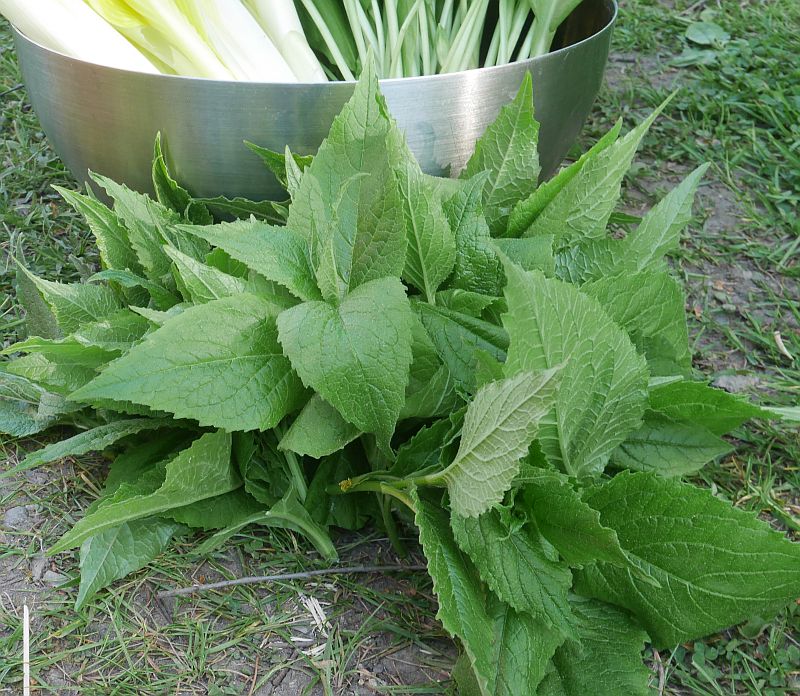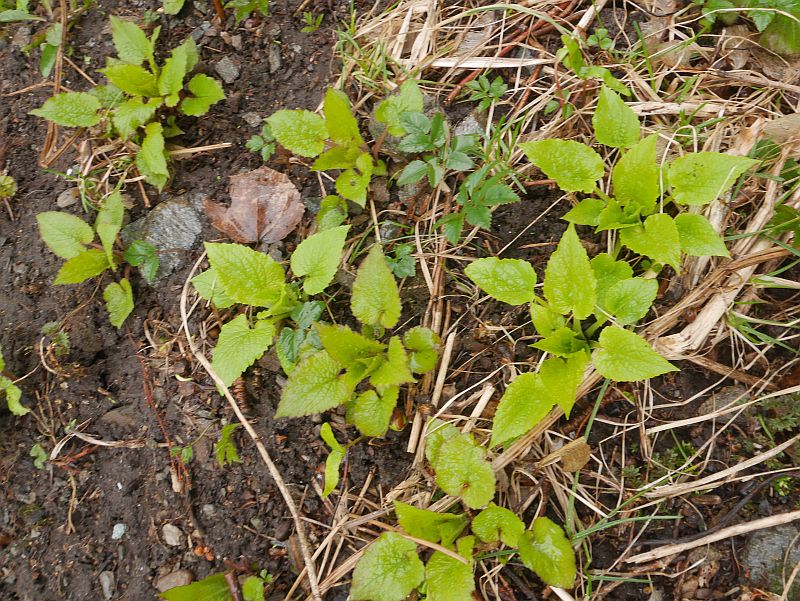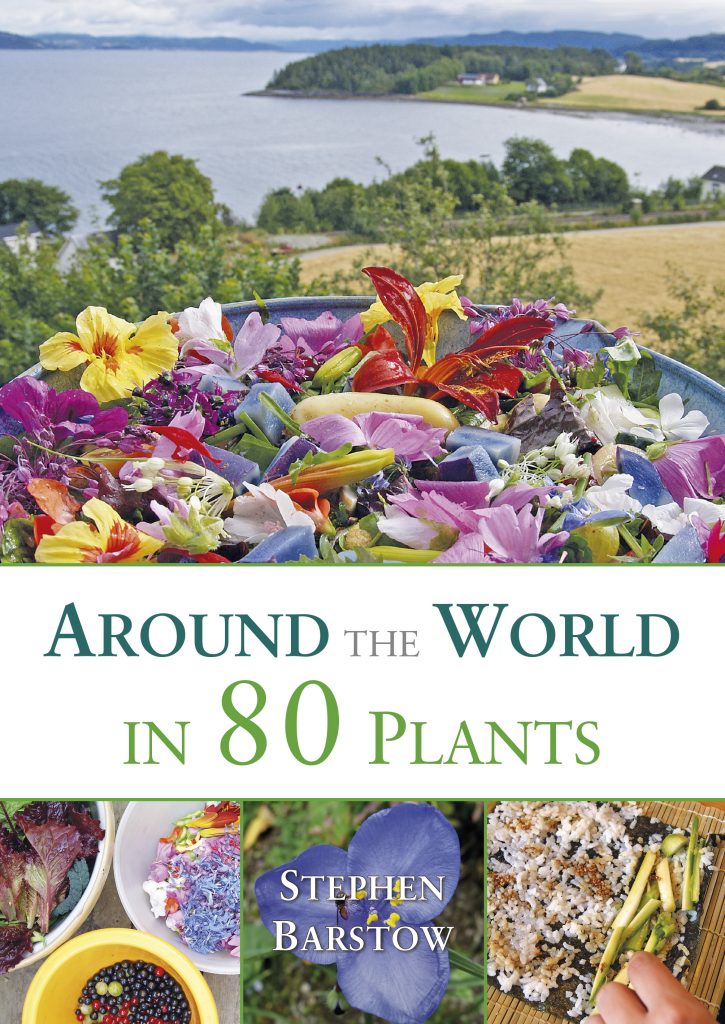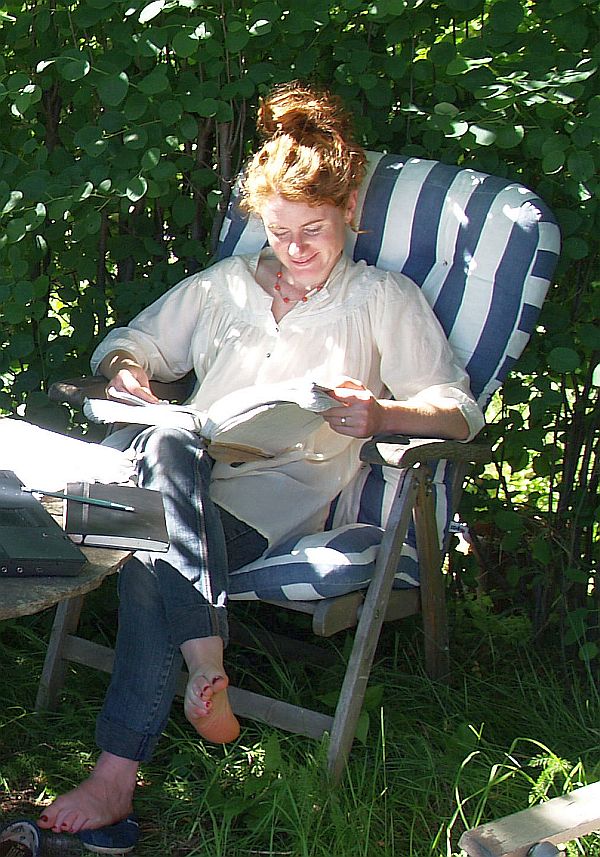Presenting some of this week’s perennial greens and, in the case of the blanched Hosta shoots, perennial whites!
Hosta sieboldiana with ramsons / ramsløk (Allium ursinum) and giant bellflower / storklokke (Campanula latifolia)


Presenting some of this week’s perennial greens and, in the case of the blanched Hosta shoots, perennial whites!
Hosta sieboldiana with ramsons / ramsløk (Allium ursinum) and giant bellflower / storklokke (Campanula latifolia)


This bucket was planted in the autumn and stored until now in the cellar. Within a few days of bringing it up into my living room there are usable shoots. Garlic bulbil shoots are seen behind.
Nowadays, I LOVE the taste of dandelion although in my youth I found it so bitter that I couldn’t understand why anyone would want to eat it. I think the reason is a combination of giving up eating sugar and getting accustomed to eating bitter plants. In addition, nobody ate a dandelion salad alone. The following box from my book describes various methods og de-bitterizing dandelions if you want to benefit from one of the most nutritious and valuable plants on the planet but find the taste too bitter:
In 2017, I was able to grow Sonchus kirkii, the original perennial sow thistle (puha or rauriki), an important traditional vegetable of the Maori which I’d long wanted to try. Unfortunately, I didn’t manage to overwinter it. It grows in coastal New Zealand and isn’t adapted to freezing winter temperatures and no doubt stays green all winter. I had been hoping to overwinter it and try the spring shoots, but I didn’t get the opportunity then. I relocated the original seed packet this spring, and the seed was still viable and the plants started flowering now in October and with unusually mild weather so far this winter with no serious frosts, I finally got round to trying some of the top growth in the tradional way to eat Sonchus oleraceus in Mediterranean countries, fried with garlic and chili in olive oil and added to scrambled eggs. The raw leaf was surprisingly mild, much milder than perennial Sonchus arvensis, which I’ve experienced as unpleasantly bitter in the past (young shoots in spring).
There is an account in my book Around the World in 80 plants of this species and annual super(healthy)weed Sonchus oleraceus which replaced it in Maori kitchens! Variously known as puha, shore puha or New Zealand sow thistle (syn. Sonchus asper var. littoralis), its habitat is described by the New Zealand Plant Conservation Network as http://www.nzpcn.org.nz/flora_details.aspx?ID=205: “Coastal. Usually on cliff faces in or around damp seepages where it often grows with the blue green alga Nostoc and fern Blechnum blechnoides. This species has a distinct preference for base rich rocks such as basalt, calcareous mudstones, siltstones, limestone or apatite-rich greywacke faces. On some offshore islands this species extends up into coastal scrub and herbfield. It occasionally grows on stabilised sand dunes. Indications are that this species once occupied a wider range of habitats but has retreated to those less suited to other faster growing introduced weeds.”
NZPCN states that it is “Easily distinguished from all the other naturalised Sonchus species by the very large, glaucous, non-spinose leaves” (this includes Sonchus arvensis – perennial sow thistle and annuals Sonchus asper and Sonchus oleraceus). The first picture shows a comparison of the autumn leaves of the two growing in my garden:
AROUND THE WORLD IN THE EDIBLE GARDEN; Part 1 – The Cherokee lands of Eastern North America
The first in a series of dinners from Malvik’s Edible Garden where we “forage” from different parts of the world!
Cherokee Pizza is of course better known as Cherokizza…go on, look it up :). This is the classic Native American Italian dish and it was made in Norway today! All you need is a good selection of Cherokee wild vegetables:
Appalachian greens / kyss-meg-over-gjerde (Rudbeckia laciniata); see http://www.edimentals.com/blog/?p=22018
Nodding onion / prærieløk (Allium cernuum)
Stinging nettle / brennesle (Urtica dioica)
Virginia waterleaf / Indian salad (Hydrophyllum virginianum)
Dandelion / løvetann (Taraxacum spp.) (a giant individual, as you will see from the pictures, growing on seaweed on the sea kale bed)
Cow parsnip (Heracleum maximum)
I used a thick 100% whole grain rye sourdough base for the pizza, so a bit of Denmark in there too!
No doubt introduced by the previous owners here as an ornamental and despite the fact I spent a lot of time trying to eradicate it from parts of the garden, Campanula latifolia (giant bellflower / storklokke) is nowadays one of my most important springtime vegetables used both cooked and raw. It has naturalised under Hazel in part of the garden! Always nice to see how plants find their own way to the best spots it grows happily alongside Aegopodium podograria (ground elder / skvallerkål). See the excerpt from my book Around the World in 80 plants below.
 Here is the excerpt from Around the World in 80 plants (I’m happy to send signed copies within Norway). “When I first moved to my present garden, there was one weed that I struggled to eradicate from my cultivated beds, Campanula latifolia or giant bellflower. The roots in particular were almost impossible to dig out, having a knack of germinating in the most difficult places. Then, one day I was reading the Norwegian book “Gratis Mat av Ville Planter (Free Food from Wild Plants; Holmboe, 1941). I learnt that my worst weed had been wild gathered for food by farmers in my area in the 17th century, a tradition which probably died out soon afterwards. The leaves and stems were collected in springtime and made into a soup. Similar stories have also survived from other parts of Norway and Sweden. Storklokke (literally large bell) is considered to be one of the most commonly used wild food plants in the past in Norway. Both the leaves and roots were used, the latter also ground and added to bread.”
Here is the excerpt from Around the World in 80 plants (I’m happy to send signed copies within Norway). “When I first moved to my present garden, there was one weed that I struggled to eradicate from my cultivated beds, Campanula latifolia or giant bellflower. The roots in particular were almost impossible to dig out, having a knack of germinating in the most difficult places. Then, one day I was reading the Norwegian book “Gratis Mat av Ville Planter (Free Food from Wild Plants; Holmboe, 1941). I learnt that my worst weed had been wild gathered for food by farmers in my area in the 17th century, a tradition which probably died out soon afterwards. The leaves and stems were collected in springtime and made into a soup. Similar stories have also survived from other parts of Norway and Sweden. Storklokke (literally large bell) is considered to be one of the most commonly used wild food plants in the past in Norway. Both the leaves and roots were used, the latter also ground and added to bread.”
It was the nephew of Bishop Gunnerus (after whom the genus Gunnera was named) who published this in Norway’s first flora published 3 years after the Bishop’s death! It was stated that “storklokke” deserves to be considered as one of the best springtime greens! I totally agree! Thanks to the previous owners (Johansen) for planting it for me!
And it’s always nice when your peers say nice things about your creation….here Joe Hollis of Mountain Gardens :) (I was sitting there though!)
Isaac John Koblentz (see his #ATWselfie) was one of 3 guys who travelled all the way from northern Ohio for the joint walk and talk I did with Joe Hollis at Mountain Gardens (North Carolina) in fall 2019! Here they tell a little bit about each other! Thanks so much for coming!

281218: I’m now sending signed copies of my book from home in Malvik with any dedication you wish!
Cost: NOK 250 plus postage
Payment either by Paypal, bank transfer or VIPPS (Norway) : Orders by email to sbarstow2@gmail.com
Around The World in 80 Plants : An Edible Perennial Vegetable Adventure For Temperate Climates, by Stephen Barstow
For book reviews, see here: http://www.edimentals.com/blog/?page_id=271
What has underground gardening in Tokyo, the origin of garlic and an English bishop got in common? They are all stories from the original, groundbreaking book, Around The World In 80 Plants. Perennial gardening will never be the same again, nor will be your kitchen repertoire!
Around The World In 80 Plants takes us on an inspiring edible adventure across the continents, introduacing us to the author’s top 80 perennial vegetables, with inspiration along the way from local foraging traditions and small scale domestication. Each plant has its own ethnobotanical story to tell; introducing Sherpa vegetables of the Himalayas; forest gardened and foraged vegetables of the Sámi people of Arctic Scandinavia; a super-vegetable of the Maori of New Zealand; an onion with a 1,000 year history linking the author’s home and Iceland ; a plant which earned the name ‘supermarket of the swamps’; the traditional veggie roof gardens of Norway; clifftop perennial vegetables of Dorset’s Jurassic coast; the Hampshire perennial vegetable triangle; Scandinavias best kept secret, a long-lived spinach that climbs; Prince Charles’ Forest Garden, and inspiring multi-species dishes of the Mediterranean countries.
A thorough description is given of each vegetable, its propagation, cultivation and uses, and also how to source seed and plants. As many of the author’s selections are what he calls ‘edimentals’ – edible and ornamental –Around the World in 80 Plants will be of interest to traditional ornamental gardeners as well as anyone interested in permaculture, forest gardening, foraging, slow-food, gourmet cooking, traditional preservation techniques and ethnobotany.
Stephen has devoted over 30 years trialling the world’s perennial vegetables. He grows more than 2,000 edible plants in his garden close to the Arctic Circle in Norway, and in 2003 earned the title ‘Extreme Salad Man’ after creating a salad using 537 varieties, inspired by multi-species Mediterranean dishes! Sprinkled with recipes inspired by local traditional gastronomy, this is a fascinating book, an entertaining adventure and a real milestone in climate-friendly vegetable growing from a pioneering expert on the subject.
Foreword by Alys Fowler:
“I have been patiently waiting for this book and then impatiently pestering for it, drumming my fingers loudly. And then one day it appears. Like everything that you have to wait for in life, it’s better for it. This book speaks of its maker … It’s a wonderfully detailed, ofteneccentric look at all the plants you’ve ever wondered were truly edible. Stephen is an extraordinarily clever man with a truly academic approach to knowledge, thus every detail you could wish for is in here. I’ve been poring over my copy and have made a list of must-try plants, planning how I can rearrange my garden this winter so I can fit in more of these. There are several reasons why Stephen’s work is so important. Firstly, the climate in which Stephen grows is not easy. True, he has a fjord to keep the worst of the freezing temperatures away, but he has a very short growing season. His garden is also on bedrock often just inches below the soil surface. He’s a committed permaculturist so you won’t find electric strimmers or extra heat for the greenhouse – all his rainwater is recycled and I have a fantastic picture of a year’s worth of Norwegian newspapers suppressing weeds. All of which amounts to this: if he can grow it, so can you. This tome is a treasure trove of truly useful perennial plants for making healthy, ecologically balanced, edible gardens. Our climate is increasingly unpredictable and many traditionally grown crops are not faring well in such conditions. We need diversity in our crops, we need people like Stephen who explore the boundaries of what’s edible and worthwhile to grow, and we need people like you to get inspired and start growing them too. Anyone who reads this book and acts on it is an early adopter of a brave new growing world. Get sowing, write about it, write to Stephen, join social media groups and tell the world that we have found new things to eat and the future tastes fine!”
Alys Fowler
Garden author and broadcaster

“Around the World in 80 Plants is more than just excellent profiles of little-known delicious vegetable crops. Stephen Barstow is one of the world’s great edible plant collectors and his stories of encountering plants in the wild, tracking down seeds of rare species, and of course growing and cooking with these species are absolute treasure. Many plant books just rehash information already written in other sources. Around the World in 80 Plants is delightfully marinated in personal experience. It will make you not only want to grow and eat these crops, but to travel to Siberia, Norway, and Chile to know them in their natural habitat. ”
Eric Toensmeier, award-winning author of Paradise Lot and Perennial Vegetables, and the co-author of Edible Forest Gardens.
“Stephen Barstow presents fascinating and useful information about his top 80 perennial leafy vegetables including lots of historical references, his and others’ recipe ideas, along with photos and more. Many of these are easily grown and can be ornamental as well as great edibles. This will be a really useful book helping extend the range of food plants for gardeners.” Martin Crawford, Agroforestry Research Trust.
“This should prove to be the most exciting book of the year for veggie gardeners, plant geeks and ethnobotanists…” Emma Cooper, author, organic gardener & blogger